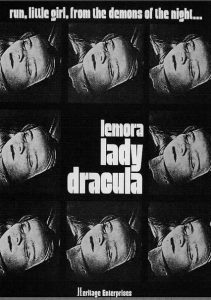Lemora: A Child’s Tale of the Supernatural-1973
Director Richard Blackburn
Starring Cheryl Smith, Leslie Gilb
Scott’s Review #1,036
Reviewed June 22, 2020
Grade: A-
Lemora: A Child’s Tale of the Supernatural (1973) is a bizarre and fascinating horror film and a great example of 1970s experimental cinema.
At the risk of stating that there may be a tad too much exploration going on since aspects go in many directions, the film is the perfect watch for a late weekend night extravaganza of the weird and wild and is a joy to view.
The fact that I am still thinking about the film days after watching is a tremendous sign. Vampires, creepy clown-like figures, a reverend, a blood-thirsty woman, and a thirteen-year-old girl make up the cast of unusual characters to feast one’s eyes upon in delight.
During the Prohibition era in the southern United States of America, a young, angelic girl named Lila Lee (Cheryl Smith) slips out one night to look for her gangster father after an anonymous and cryptic tip.
Lila is someone of note in her small town, envied by many in the church where she preaches with the local Reverend (Richard Blackburn).
She treks along swampy territory to the strange town, Astaroth where her father is being held. After Lila is attacked by vampires a strange woman named Lemora (Lesley Gilb) helps her and gives her a place to reside, but Lila soon begins to wonder if Lemora is a friend or a foe.
For such a low-budget affair the visual details are superb.
The photography and the use of lighting are particularly honorable. Many characters ooze with glowing fright, especially Lemora. The ghostly white color enhances her blood-red lips offering a pasty and haunting image that is ghastly to the eyes.
If done at a sloppy level the result could easily have been juvenile or comedic (not in a good way), but the elements fall together in an easy flow that combines horrific details that fascinate.
The best characters are Lila and Lemora and their scenes together are immense. Gilb is the standout and brings a monotone, wide-eyed performance reminiscent of a talking Bride of Frankenstein.
She frightens the audience, to say nothing of Lila, and is a fantastic villain.
Beautiful and erotic, her sexuality is in question.
Lila, young, fresh-faced, and developing, is ripe for the picking by Lemora, but I was perplexed if Lemora wanted her blood or her other parts. The vague, but suggested lesbianism and sexual abuse of a child only enhance the mystique and macabre qualities. When Lemora bathes Lila this is where it’s most evident.
I adore films that challenge the norm and attempt to break the mold of your typical carbon copy film or a formulaic script, but there is none to be had in Lemora: A Child’s Tale of the Supernatural and it keeps the viewer guessing.
Comparisons to the brilliant The Night of the Hunter (1955) have been made and while I don’t quite see that, a chilling fairy tale concept exists. Think Hansel and Gretel, the Brothers Grimms German fairy tale, sans Hansel.
Lila’s pigtails and little girl’s dress give her a child’s vulnerability and appearance.
While deserving of credit for bravery and letting loose from a story perspective, there is a measure of disorder and confusion as to what is going on that perplexed me.
Blackburn, who also plays the Reverend, offers many creatures who are on the attack, coming out of nowhere to scare Lila. Unclear is who they are (or were!) and what their motivations are.
Why does Lemora like to feed on children? Is she holding Lila’s father captive to lure her into her clutches? Is Lila’s blood more desirable than other children’s? The plot points are uneven but maybe that doesn’t matter.
A suggestion, if plausible, is to check out the uncut version of the film. I saw the cut version which was trimmed by nearly forty minutes and released theatrically in late 1974.
Tough to find, I wonder if this would provide more clarity to several plot items. Lemora: A Child’s Tale of the Supernatural (1973) was heavily criticized by the Catholic Legion of Decency who deemed it “anti-Catholic”, which is more than enough reason to give it a whirl.
